Transportation & Infrastructure
Learning Objectives:
- Discuss the environmental challenges and benefits involved in transforming underutilized transportation facilities and industrial infrastructure into parkland.
- Outline architectural approaches for reducing traveler stress and promoting well-being at airports.
- Describe strategies for overcoming the logistical and construction challenges of expanding and upgrading existing transportation infrastructure without disrupting operations.
- Discuss the civic, community-building, and placemaking opportunities of transportation buildings.
Credits:
This course is approved as a Structured Course
This course can be self-reported to the AANB, as per their CE Guidelines
Approved for structured learning
Approved for Core Learning
This course can be self-reported to the NLAA
Course may qualify for Learning Hours with NWTAA
Course eligible for OAA Learning Hours
This course is approved as a core course
This course can be self-reported for Learning Units to the Architectural Institute of British Columbia
View course on architecturalrecord.com
It is the journey, not the destination—so the saying goes. This month, RECORD turns this aphorism on its head, looking at the points of arrival (and departure) for traveling by plane, train, and sea. We examine innovative transportation buildings, at a range of scales, from a diminutive subway headhouse for a station in Cambridge, Massachusetts, to a vast, greenery-filled airport terminal in India. We also explore efforts to breathe new life into defunct infrastructure, including the transformation of what once was the world’s largest landfill into a sprawling park for the people of New York.
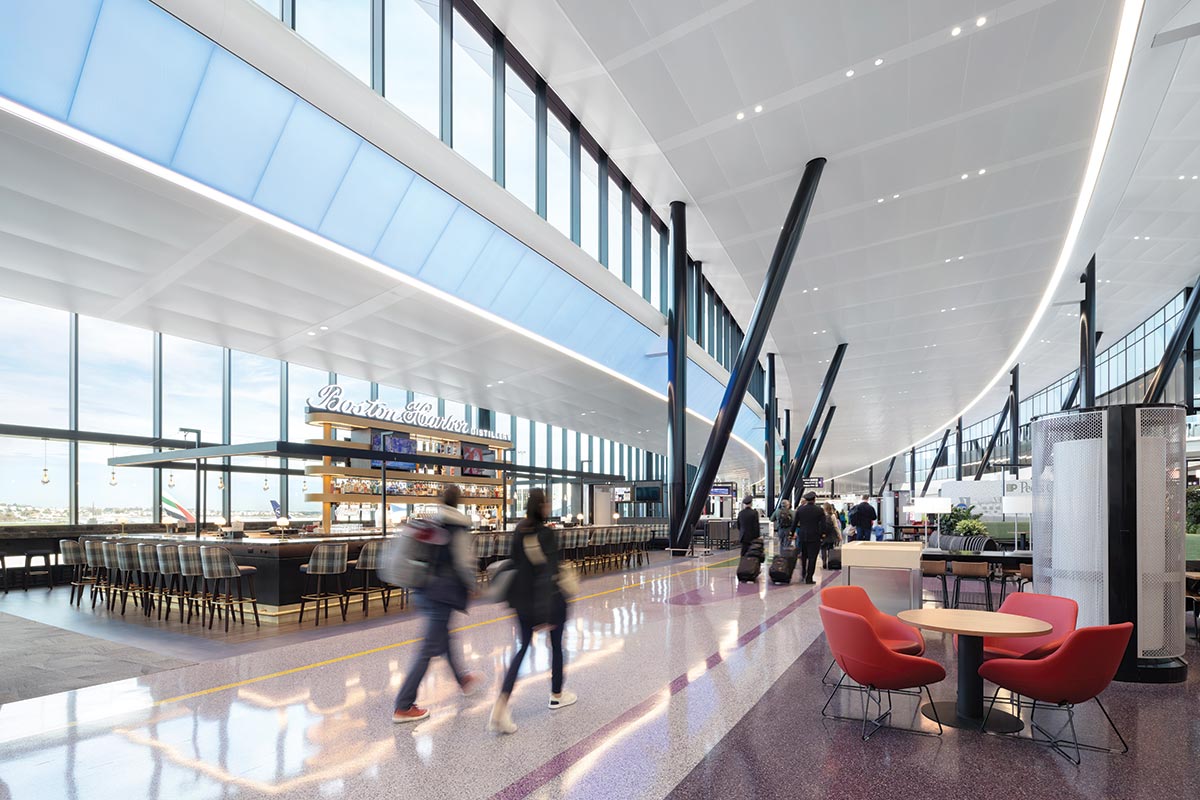
Photo © Ema Peter
Logan, Terminal E
Paint the Town Red
Flashy on the outside, Logan Airport’s new terminal is all about reducing passenger stress on the inside.
BY JOANN GONCHAR, FAIA
These days, air travel is mostly filled with aggravation and indignities, with long queues, having to remove your shoes for security screening, and jostling with fellow passengers for the limited overhead baggage space. It wasn’t always so. Flying used to be glamorous. And if any buildings epitomize that long-faded romance, it would be those of Eero Saarinen—the TWA Flight Center at Idlewild Airport in New York (now JFK) and his terminal at Washington Dulles, both of which opened in 1962—with their gravity-defying winglike forms in poured-in-place concrete. Now Boston Logan International Airport has a building that alludes to that era, with an addition to Terminal E. It seductively swoops and curves, but instead of volumes defined by concrete, the new structure has a lipstick red chassis, like a sports car.
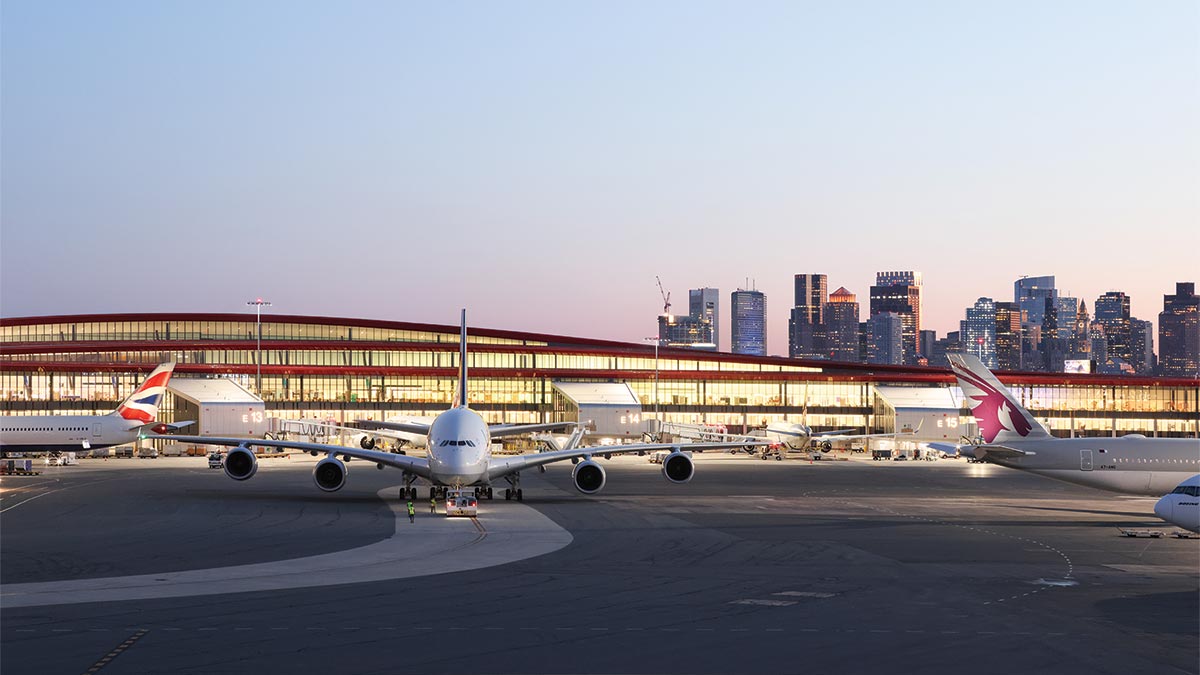
Photo © Ema Peter
The $800 million expansion and renovation project has been designed by infrastructure specialists AECOM and, as the project’s “vision architect,” luis vidal + architects (LVA), a Madrid-based firm known for airport buildings with expressive skylit roofs, including Zaragoza, in Spain (2008) and Terminal 2 at London’s Heathrow (2014). Their scheme adds 320,000 square feet and four gates, bringing the total at Logan’s international terminal to 16. (The project was originally conceived as seven new gates, but, due to pandemic-related revenue losses, the three additional gates have been postponed).
So why red? Luis Vidal, LVA founder, says it was inspired by Boston itself: by the city’s brick buildings, the Red Sox, and the school colors of several of its universities. The hue for Terminal E’s cladding was developed with the coating’s Swiss manufacturer specifically for the project, and, because the paint contains glass particles, it has a prismatic effect, ranging—depending on the angle of the sun—from intense candy apple shades to orange tones.
If Vidal’s contextual argument seems tenuous, coming off as a justification, the surprisingly bold choice is effective. The color adds a sense of excitement to what had been a rather humdrum airport and makes the addition unmissable: from Boston’s Seaport district, you can appreciate its full 1,350-foot-long horizontal sweep; depending on the side of the plane you might be sitting on and its flight path, the sculptural roofscape can be spotted from the air; and you can catch oblique views of the brightly hued structure when arriving in an Uber or while moving between terminals over one of the airport’s connecting sky bridges. Just like the sexy curves of a classic sports car, Terminal E’s addition seems designed to get your heart racing—at least on its outside.

Photo © Ema Peter
From Boston’s Seaport District, one can appreciate the addition’s full horizontal sweep. Clerestory windows help create a daylight-filled interior.
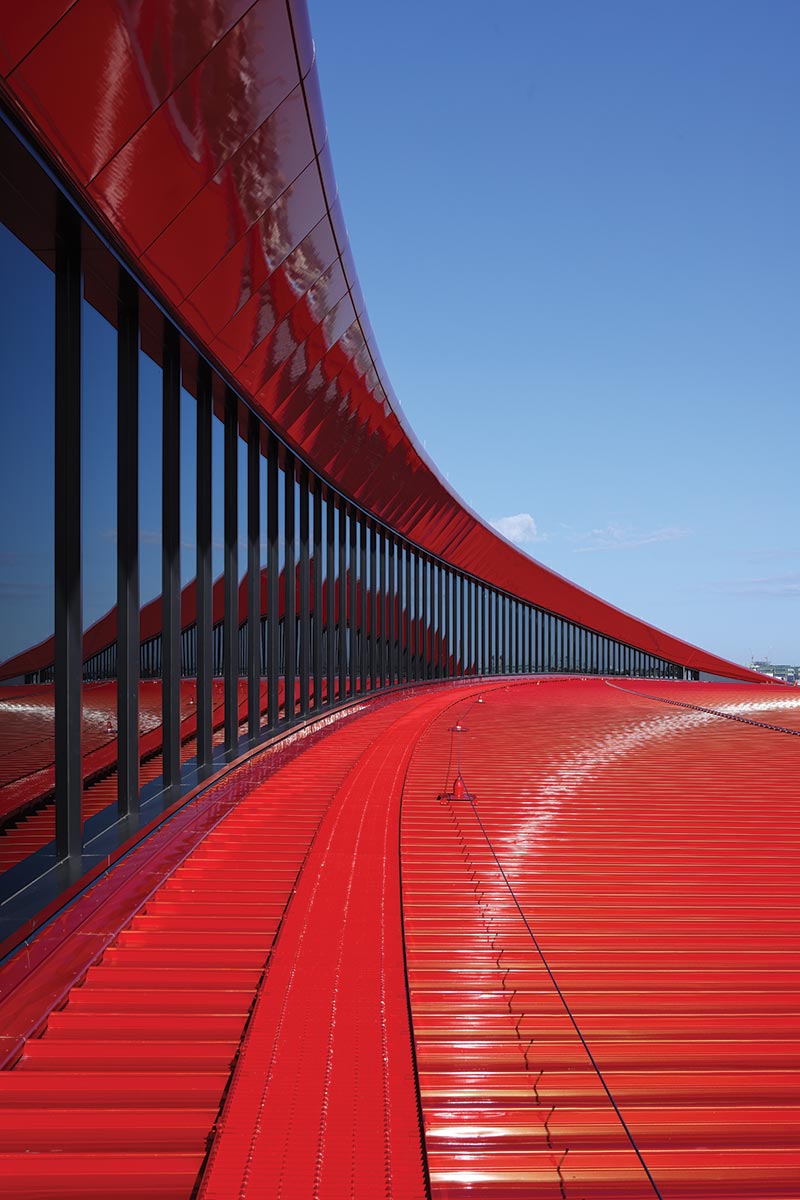
Photo © Ema Peter

Photo © Ema Peter
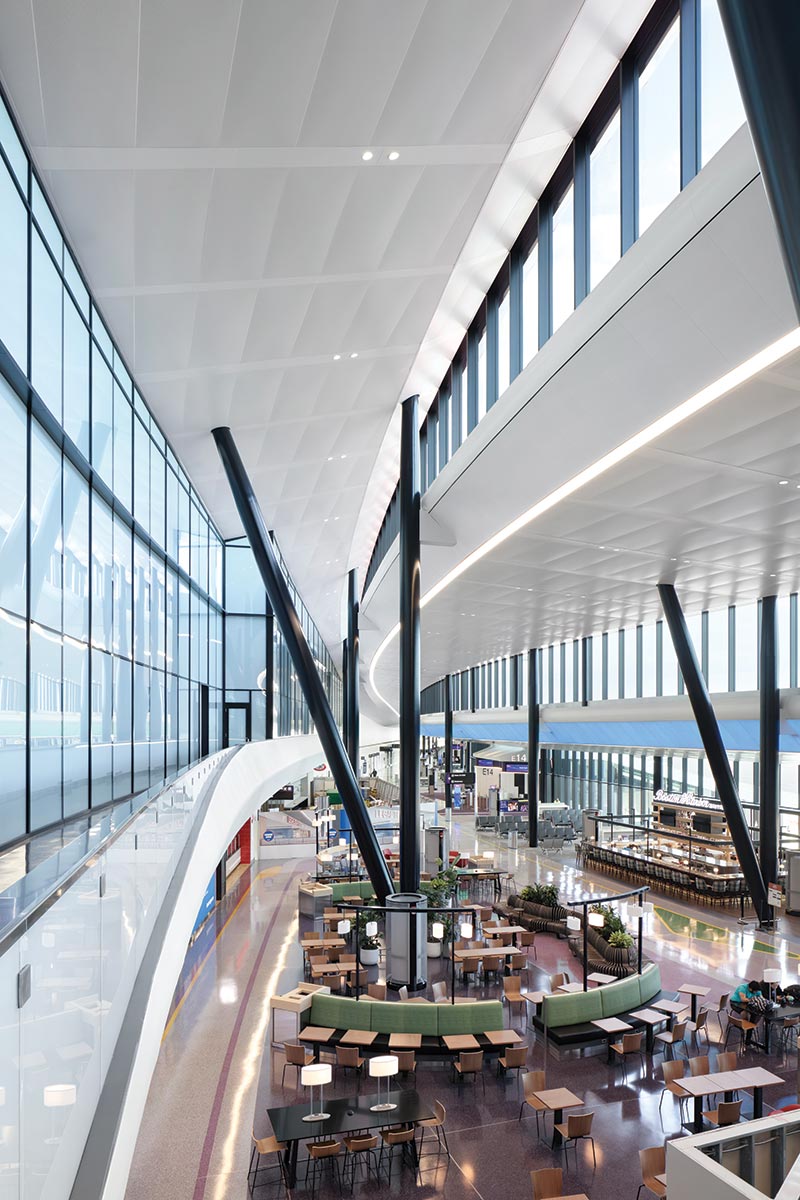
Photo © Ema Peter
On the inside, however, the effect is intentionally just the opposite. Here one is hardly aware of the adrenaline-inducing red. Instead, the environment is cool and calm, with ample daylight and finishes rendered primarily in white, including terrazzo floors, perforated metal ceiling panels, and curving drywall. Seemingly every move has been made with the idea of reducing the anxiety associated with air travel.
To understand travelers’ typical pain points, the team worked with a behavioral psychologist, says Terry Rookard, AECOM project director. Some of the outcomes of this collaboration are amenities, including a roomy “recomposure” area after security with plenty of seating, a lactation room, a pet-relief area, and a calming room where neurodivergent travelers can acclimate themselves before a flight. But the main factor is the openness of the addition and its boomerang-like footprint. By avoiding the use of right angles on the L-shaped site, designers have produced a departures level with clear sight lines and intuitive circulation. For instance, the configuration allows travelers to see almost all the gates while they are waiting to go through security, even though the distance from the screening area is more than 1,000 feet. Meanwhile, the scale of the interior expands and contracts to accommodate the flow of passengers: the ceiling is highest (reaching nearly 60 feet) and the floor plate widest at the addition’s midsection, with the volume becoming appropriately shorter and skinnier, tapering where foot traffic is the lightest—as one approaches the final gate.
Helping guide passengers past the duty-free shop, the restaurant, other concessions, and to the gate waiting areas are two roughly parallel “streets,” demarcated with change of floor finish or colors. These circulation paths track with the contours of the ceiling and are further articulated by the structural grid comprising pairs of V-shaped steel columns (filled with concrete to avoid the need for fireproofing) marching down the length of the terminal.
The interior has an airy feel that is in no small part due to its daylighting scheme, which includes two tiers of clerestories. Because they are predominantly, but not entirely, north-facing, they are shielded from direct sun by overhangs that Vidal refers to as “eyelashes.” Similarly, the generous curtain wall looking out onto the runways includes electrochromic glazing, which darkens to reduce heat gain and glare. The daylighting, along with features such as building-integrated photovoltaics on the south facade, displacement ventilation (which supplies conditioned air only to the occupied portions of the tall terminal volume), and all-electric building systems are part of the addition’s bid for LEED Gold certification.
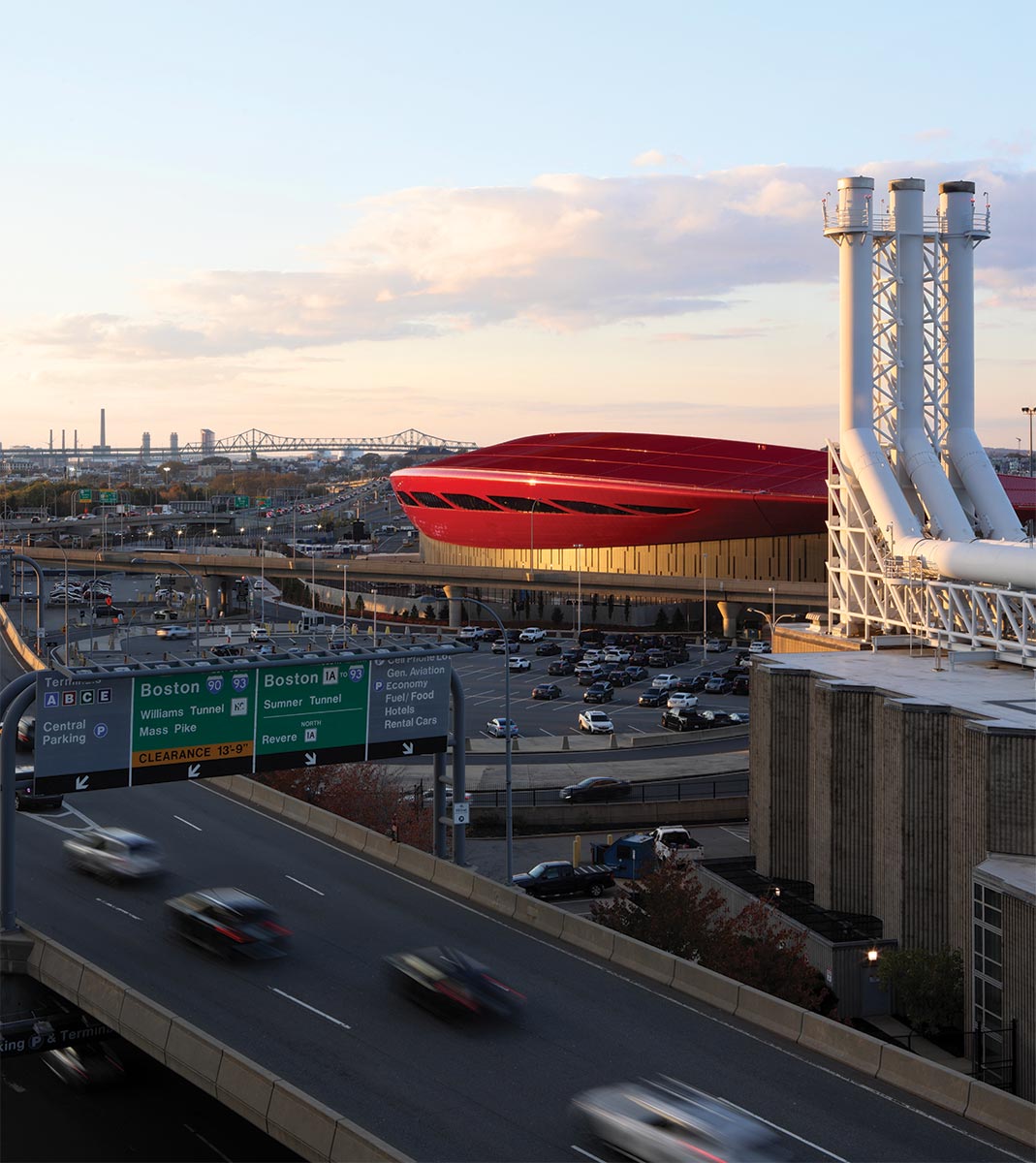
Photo © Ema Peter
Below the portion clad in fire-engine red panels, the south facade includes building-integrated photovoltaics.
The sustainable strategies also contribute to the net zero goal set by the Massachusetts Port Authority (Massport), the airport’s owner, to reach net zero by 2031. But before that can be achieved, the central heating plant will need to be overhauled, since it is the facility’s largest carbon emitter, according Luciana Burdi, Massport director of capital programs and environmental affairs.
The project team faced several construction and engineering challenges, including building over an existing baggage-handling system, whose operation could not be disrupted. To deal with the problem, structural engineers from Thornton Tomasetti devised a mega-truss to span the baggage-handling system and support the portion of the terminal above. And then there are the expansion’s signature curves. There are so many, in fact, that Jonathan Rushmore, AECOM design manager, likes to joke that the only flat surface is the floor plane. Most bend in more than one direction, and with different radii, creating the potential for a fabrication and construction nightmare. But Sam Sleiman, executive vice president at Suffolk Construction, the project’s construction manager, points to the “federated” BIM model shared among the consultants, trades, and subcontractors. As a result, the building feels tightly coordinated and cleanly detailed.
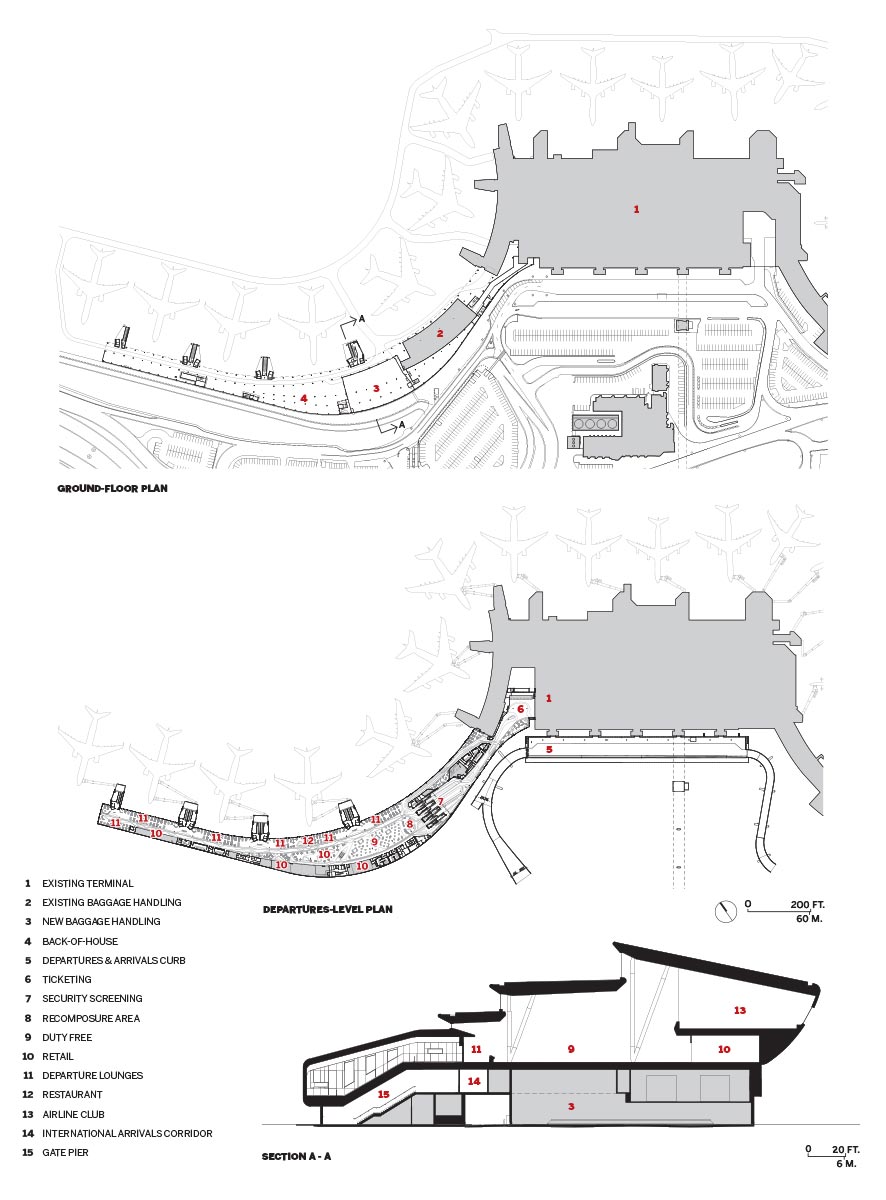
Below the portion clad in fire-engine red panels, the south facade includes building-integrated photovoltaics.
On the whole, the new interior is smart, bright, and spacious. Its mood, however, doesn’t quite match the drama of the exterior—not to mention that of Saarinen’s terminals. But drama-free flying is what today’s travel-weary passenger desires. The expansion of Terminal E succeeds in delivering the kind of smooth airport experience most of us want, while providing a burst of visual energy for Logan and a new landmark for Boston.
















